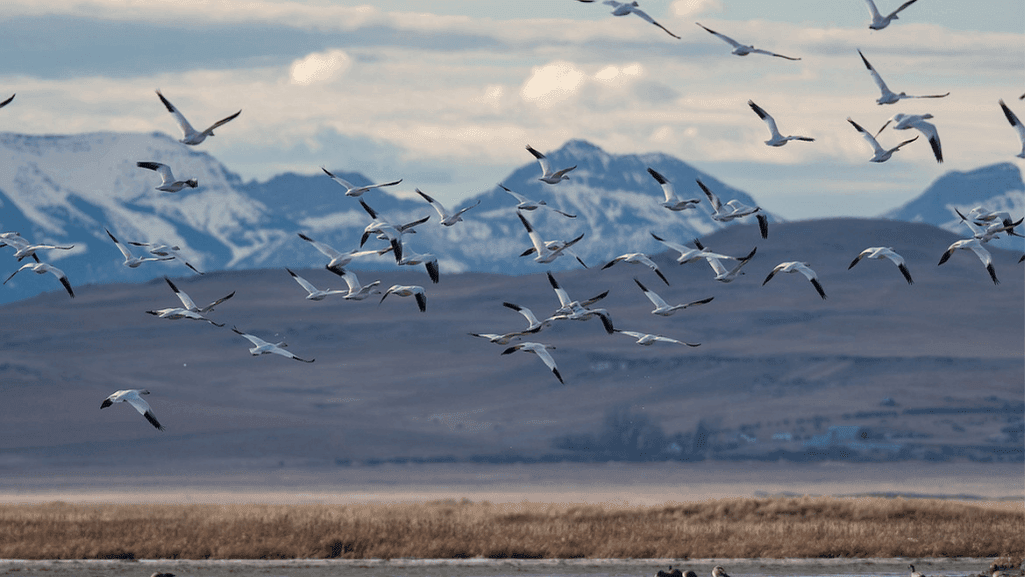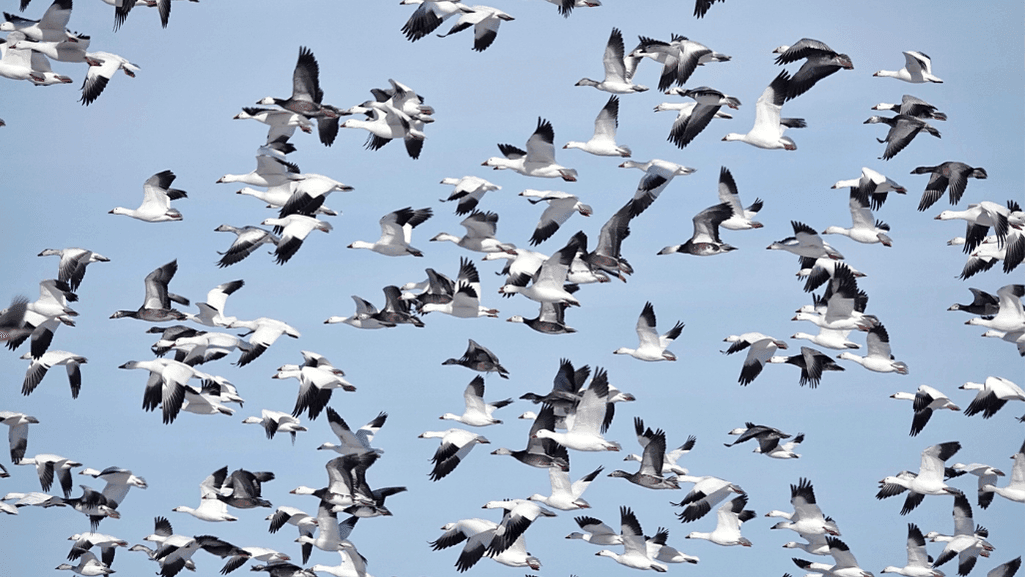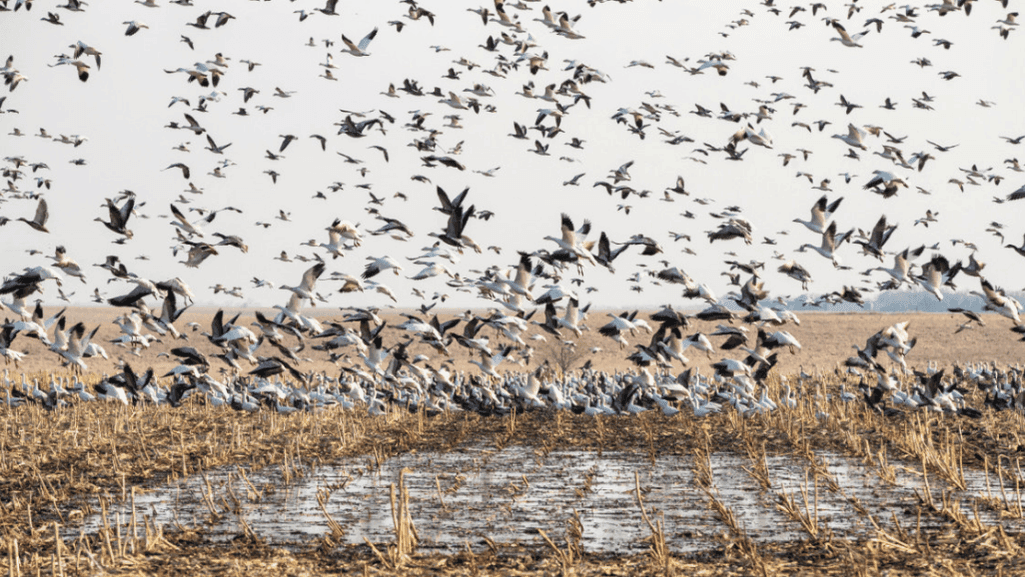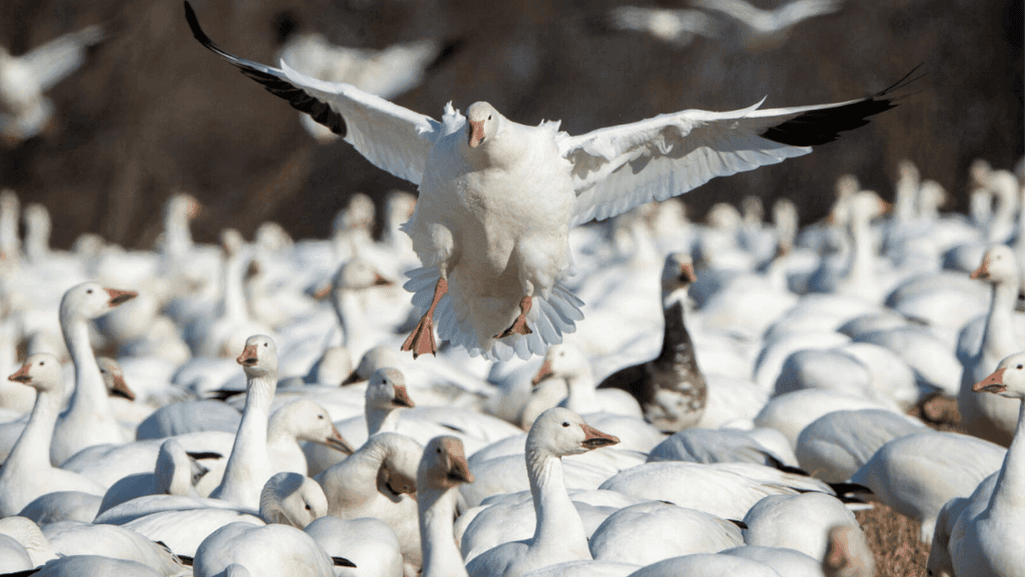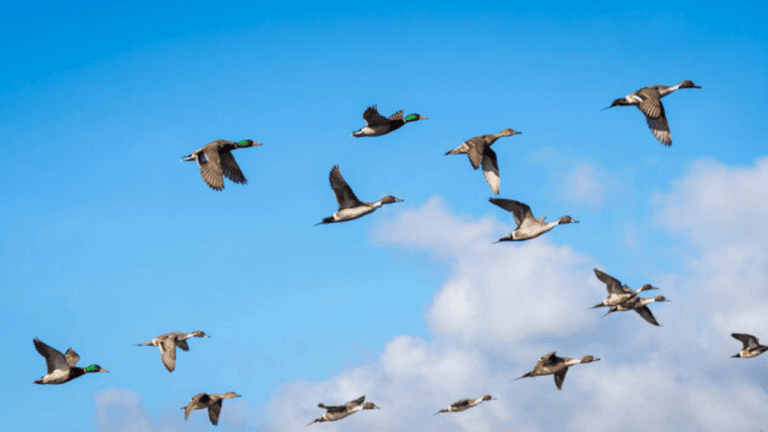Every year, a stunning wildlife event happens in North America. Snow geese start their long journey. They fly in huge, loud groups, sometimes with tens of thousands of birds.
These birds travel from their winter homes in the U.S. to their breeding grounds in Alaska and Canada. It’s a remarkable sight to see.
Watching snow geese fly is awe-inspiring. Their black-tipped white wings and perfect timing make it a beautiful sight. During the peak migration, up to 100,000 birds fill the sky. It’s a sight that amazes everyone who sees it.
Snow geese migrate the farthest of any waterfowl. They travel thousands of miles each year. Their journey shows their strength and ability to adapt to different places and weather.
Key Takeaways
- Snow geese migrate in massive flocks, often numbering in the tens of thousands.
- Flocks can swell to close to 100,000 birds during peak migration times.
- Snow geese travel thousands of miles annually between wintering grounds in the U.S. and breeding grounds in Alaska and Canada.
- The sight of a snow geese flock in flight is a breathtaking wildlife spectacle.
- Snow geese undertake one of the longest migrations of any waterfowl species.
Introduction to Snow Geese
Snow geese are amazing migratory birds with white and black feathers. They are common in North America. There are two types: lesser and greater snow geese. They also have a blue morph, seen more in the Midwest and Gulf Coast.
Overview of Species Characteristics
Snow geese are medium-sized waterfowl. The lesser snow goose is 64 to 79 cm tall and weighs 2.05 to 2.7 kg. The greater snow goose is slightly taller and heavier, sometimes up to 4.5 kg.
These birds mate for life, usually in their second year. They start breeding around their third year. The female lays eggs for 22 to 25 days. The young leave the nest hours after hatching.
Unique Habitats of Snow Geese
Snow geese breed in the far north tundra. This area has plenty of food and is safe for their young. In the nonbreeding season, they gather in huge flocks.
These flocks can have hundreds of thousands of birds. Snow geese also use agricultural fields, helping their population grow.
Importance of Snow Geese in Ecosystems
Snow geese are vital in the ecosystems they visit. They are not considered endangered, but face threats. In 2015, an avian cholera outbreak killed 2,000 snow geese in Idaho.
Despite being rare in Europe, they have feral populations in places like the British Isles. This shows their ability to adapt to different habitats.
To learn more about snow geese, visit All About Birds. They have detailed information on their migration and behavior.
Migration Patterns of Snow Geese
Snow geese are famous for their amazing migratory routes. They travel long distances across the continent. They migrate twice a year, covering up to 4,800 km.
Their journey starts in mid to late winter for the spring migration. The fall migration begins in early autumn.
Timing and Routes of Migration
Snow geese are split into three main groups: western, mid-continent, and eastern. Each group has its own migration route and timing. For example, greater snow geese migrate about 3,000 miles to the Arctic.
Peak migration is seen from mid-February to mid-March. Flocks of several thousand birds can be seen taking off and landing together.
Factors Influencing Migration
Weather and food availability affect snow geese migration. Warmer weather and strong south winds push them forward. Cold temperatures and northerly winds can slow them down.
The right stopover sites, like wetlands and agricultural fields, are also key. These areas provide food and rest.
“Snow geese are one of the world’s most abundant waterfowl species, with recent estimates suggesting near one million greater snow geese and ten million lesser snow geese.”
Notable Stopover Locations
Snow geese stop in open spaces or habitats during migration. They gather in large flocks, making a lot of noise with their honks. Places like the Middle Creek Wildlife Management Area in Lancaster and Lebanon counties are famous for this.
Missouri is also a key spot for spring migration. It attracts hunters with its wetlands, marshes, and crop fields.
Flocking Behavior in Snow Geese
Snow geese are famous for their flocking behavior. This behavior is key to their survival and migration success. They travel and forage in large, noisy groups, creating a spectacular sight for birdwatchers and nature enthusiasts. Their flocking behavior shows how social structure, communication, and coordination work together in the animal kingdom.
Why Geese Flock Together
Flocking together has many benefits for snow geese. When flying in a V-formation, each goose helps the bird behind it, making the flock fly further with less effort. This is very important during long migration flights. Also, being in a large flock makes them safer, as more eyes can spot threats and alert the group.
Social Structure Within Flocks
The social structure of snow geese flocks is complex and fascinating. Birds mimic the maneuvers of distant flock members, coordinating their movements to maintain cohesion. This is evident during migration, when geese must navigate vast distances together. The front position in the V-formation rotates among all geese, preventing fatigue for the leading bird and showing a sense of shared responsibility within the flock.
Snow geese also show remarkable loyalty and support for their fellow flock members. If a goose falls out of formation due to injury or illness, others will stay with it until it can fly again. This behavior highlights the strong social bonds that exist within snow geese flocks.
Communication and Coordination
Effective communication is essential for maintaining flock cohesion and coordinating movements. Snow geese use their distinctive honking calls for multiple purposes. These calls encourage and motivate the flock during flights, alert others to threats or food sources, and help individual birds locate their family members within the larger group. Mastering the art of goose calling can greatly enhance a hunter’s success in the field, as it allows them to mimic the natural sounds of geese and attract them to their location.
The flocking behavior of snow geese is a testament to the power of social structure, communication, and coordination in the animal world. By working together, these birds can overcome challenges, ensure their survival, and embark on incredible journeys year after year. As birdwatchers and researchers continue to study snow geese, we gain a deeper appreciation for the complexity and beauty of their flocking behavior.
Conservation Efforts for Snow Geese
Snow Geese populations have grown a lot, with over 1.4 million in North America. This growth is causing harm to natural habitats. Conservation efforts are needed to keep their numbers in check.
At Middle Creek Wildlife Management Area in Pennsylvania, up to 200,000 Snow Geese gather. This is due to plenty of food in U.S. fields and less hunting. These factors have helped their numbers soar.
Current Threats to Snow Goose Populations
Despite their numbers, Snow Geese face many threats. Overgrazing in their Arctic homes is a big problem. Human actions like land changes and hunting also harm them.
Key Conservation Programs
Several conservation programs aim to help Snow Geese:
- The Atlantic Flyway has a Conservation Order to control their numbers.
- Work is underway to protect their Arctic breeding grounds.
- In Coral Harbour, Nunavut, Canada, the community is getting help to manage goose numbers.
Community Involvement in Conservation
Community involvement is key for Snow Goose conservation. Hunters in the Atlantic Flyway face challenges like finding food and learning new hunting methods. Working together and hunting responsibly can help manage their numbers.
“Historical perspectives show a deep connection between migratory birds and human cultures, specially in traditional diets and hunting practices of Indigenous communities.”
Understanding Snow Geese’s cultural and historical value can inspire community action. This can lead to more people helping in conservation efforts.
Best Locations to Observe Snow Geese Flocks
Watching snow geese flocks is a memorable experience for bird watchers and nature fans. Their white feathers and black wing tips make them a stunning sight. They migrate between the Arctic and North America’s winter spots. Here are the top places to see them and tips for great photos.
Prime Migration Viewing Spots
There are many places to see snow geese on their way. Some of the best spots include:
- Skagit Valley, Washington State: From November to March, huge flocks of snow geese stay here. They travel about 3,000 miles from Wrangel Island.
- Fort Boise Wildlife Management Area, Idaho: In March and April, thousands of snow geese pass through. This area is about 50 miles west of the wildlife refuge.
- Midwestern States: In March, snow geese travel north. They go along the Idaho-Oregon border and through the midwest, near the Mississippi River.
Ideal Time for Observing Snow Geese
The best time to see snow geese migration changes with location and direction. Generally, the peak times are:
- Spring Migration: In March and April, they head north to the Arctic Circle and Alaska.
- Fall Migration: From September to November, they move south. They spread out from the midwest to warmer states and their winter spots.
Using the eBird app, other users reported an estimated sighting of 10,000 snow geese in the area.
Photography Tips for Capturing Flocks
Here are some photography tips for amazing snow geese photos:
- Use a long lens: A lens of at least 400mm lets you get close shots without disturbing them.
- Employ a fast shutter speed: Use 1/1000th of a second or faster to freeze their flight.
- Adjust exposure settings: Snow geese’s white feathers can fool your camera. Underexpose slightly to avoid bright spots.
- Be patient and prepared: Get there early and be ready to capture the moment when they fly or rest.
The Role of Snow Geese in Climate Change Research
Snow geese are key indicators of ecosystem health and climate change impacts. As global warming changes seasonal events and resource availability, researchers study its effects on their migration patterns and breeding success. They aim to understand how snow geese adapt to environmental changes and the effects on their ecosystems.
Impacts of Climate Change on Migration
Climate change has greatly affected snow goose migration patterns. In Alaska’s Colville River Delta, their population has grown by 35% yearly, with spring snowmelt arriving 17 days earlier. This early thaw allows snow geese to have more goslings, showing they adapt well to these changes.
Yet, the warming trend makes it hard for birds to migrate on time. This affects their ability to find enough food for their young.
Snow Geese as Indicators of Ecosystem Health
Snow geese are vital indicators of Arctic ecosystem health. Their population has grown significantly, raising concerns about overgrazing and habitat damage. The increased numbers can harm ground cover and soil quality, impacting other bird species.
Monitoring snow geese populations is key to understanding Arctic ecosystem health.
Future Research Directions on Snow Geese Migration
Future research on snow geese migration will explore several areas. Scientists will study how climate change affects wetland vegetation and food sources. They will also look into migration route changes, behaviors, and resting area quality.
Protecting wetlands and stopover locations is vital for snow goose migration. Understanding human-induced climate change effects on their habitats is also a focus of future research.



